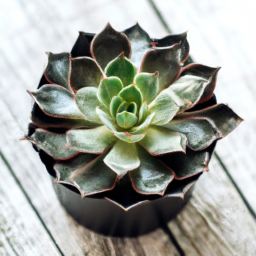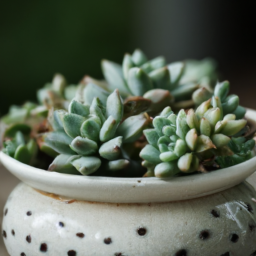
Are you looking to add some greenery to your indoor space? Indoor succulents are a great option to consider! With their unique shapes, colors, and low maintenance needs, succulents are perfect for adding a touch of nature to any room. In this blog post, we will explore the different types of indoor succulents available, from classic favorites like aloe vera to more unique varieties like string of pearls. So, whether you’re a seasoned plant parent or just starting out, there’s a succulent out there for everyone!
Common Types of Indoor Succulents
Echeveria
Overview
Echeveria is a popular type of indoor succulent known for its rosette-shaped leaves and vibrant colors. These plants are easy to care for and come in a variety of shapes and sizes, making them a favorite among succulent enthusiasts.
One of the most common types of echeveria is the Echeveria ‘Lola’, which features pale lavender leaves with pink edges. Another popular variety is the Echeveria ‘Perle von Nurnberg’, known for its striking purple and pink hues.
These succulents thrive in bright, indirect light and well-draining soil. They should be watered sparingly, allowing the soil to dry out completely between waterings.
Care Tips
To care for your echeveria, make sure to place it in a sunny spot where it can receive at least six hours of sunlight per day. Water the plant only when the top inch of soil is dry, and be sure to avoid getting water on the leaves to prevent rot.
During the growing season, you can fertilize your echeveria with a diluted succulent fertilizer every few weeks to promote healthy growth. If you notice any pests, such as mealybugs or aphids, you can remove them with a cotton swab dipped in rubbing alcohol.
With proper care, your echeveria will reward you with beautiful blooms and vibrant foliage year-round.
Sedum
Overview
Sedum is another popular type of indoor succulent that comes in a wide range of shapes, sizes, and colors. These plants are known for their fleshy leaves and low-maintenance care requirements, making them ideal for beginner gardeners.
One of the most common types of sedum is the Sedum rubrotinctum, also known as the Jelly Bean plant, which features round, jellybean-like leaves that change color in response to sunlight. Another popular variety is the Sedum morganianum, or Burro’s Tail, which has long, trailing stems covered in plump, blue-green leaves.
These succulents prefer bright, indirect light and well-draining soil. They should be watered sparingly, allowing the soil to dry out between waterings.
Care Tips
To care for your sedum, place it in a sunny spot where it can receive at least four to six hours of sunlight per day. Water the plant only when the top inch of soil is dry, and be sure to avoid overwatering to prevent root rot.
You can fertilize your sedum with a diluted succulent fertilizer every few weeks during the growing season to encourage healthy growth. If you notice any pests, such as spider mites or scale insects, you can remove them with a gentle spray of water or insecticidal soap.
With proper care, your sedum will thrive and provide you with year-round beauty in your indoor garden.

Best Indoor Succulents for Beginners
Welcome to the wonderful world of indoor succulents! If you’re new to succulent gardening, you may be wondering which types of succulents are best suited for indoor environments. In this guide, we’ll explore some of the best indoor succulents for beginners, along with tips on how to care for them.
Echeveria
Echeveria is a popular choice for indoor succulent gardening due to its beautiful rosette shape and wide variety of colors and textures. These plants are easy to care for and can thrive in a variety of indoor environments. Echeverias prefer bright, indirect light and well-draining soil. Water them only when the soil is dry to the touch, as overwatering can cause root rot.
One of the most common mistakes beginners make with Echeverias is overwatering. These plants are drought-tolerant and can survive long periods without water. To ensure your Echeveria thrives, water sparingly and provide plenty of sunlight. With the right care, your Echeveria will reward you with beautiful blooms and vibrant foliage.
There are many different varieties of Echeveria to choose from, so feel free to experiment and find the ones that best suit your indoor space. Some popular varieties include Echeveria ‘Lola’, Echeveria ‘Perle von Nurnberg’, and Echeveria ‘Black Prince’.
Sansevieria
Sansevieria, also known as Snake Plant or Mother-in-Law’s Tongue, is another great choice for beginners. These plants are incredibly low-maintenance and can thrive in low light conditions, making them perfect for indoor environments with limited sunlight. Sansevierias are also known for their air-purifying properties, making them a great choice for improving indoor air quality.
To care for your Sansevieria, place it in a well-draining potting mix and water sparingly. These plants are drought-tolerant and can survive long periods without water, so be sure to let the soil dry out completely between waterings. Sansevierias prefer indirect light but can also tolerate low light conditions, making them versatile plants for indoor spaces.
There are many different varieties of Sansevieria to choose from, ranging from tall, upright varieties to shorter, more compact ones. Some popular varieties include Sansevieria trifasciata, Sansevieria cylindrica, and Sansevieria moonshine.
Sedum
Sedum is another great choice for beginners looking to grow indoor succulents. These plants are known for their fleshy, water-storing leaves and their ability to thrive in a variety of indoor environments. Sedums come in a wide range of shapes, sizes, and colors, making them a versatile choice for indoor gardens.
To care for your Sedum, plant it in well-draining soil and place it in a sunny spot with plenty of indirect light. Water sparingly, allowing the soil to dry out completely between waterings. Sedums are drought-tolerant plants that can survive long periods without water, so be sure not to overwater them.
There are many different varieties of Sedum to choose from, including trailing varieties that are perfect for hanging baskets and upright varieties that are great for adding height to your indoor garden. Some popular varieties include Sedum rubrotinctum, Sedum morganianum, and Sedum adolphii.

Unique Varieties of Indoor Succulents
Echeveria
Echeveria is a popular choice for indoor succulent enthusiasts due to its rosette-shaped leaves and vibrant colors. These plants come in a variety of shapes and sizes, making them a versatile option for any indoor space. Echeverias require plenty of sunlight to thrive, so be sure to place them near a sunny window.
One unique variety of Echeveria is the Echeveria ‘Lola’, which features blue-green leaves with pink edges. Another popular choice is the Echeveria ‘Perle von Nurnberg’, known for its purple and pink hues. These plants are relatively low-maintenance and can be propagated easily by removing offsets or leaves.
When caring for Echeverias, be sure to water them sparingly and allow the soil to dry out between waterings. These plants are susceptible to root rot if overwatered, so it’s important to monitor their moisture levels regularly. With the right care, Echeverias can thrive indoors and add a pop of color to any room.
Haworthia
Haworthias are another unique variety of indoor succulents known for their striking appearance and easy care requirements. These plants have thick, fleshy leaves arranged in a rosette pattern, making them a visually appealing addition to any indoor space. Haworthias prefer bright, indirect light and can thrive in a variety of indoor environments.
One popular variety of Haworthia is the Haworthia cooperi, which features translucent leaves with white veins. Another unique option is the Haworthia attenuata, also known as the zebra plant, due to its striped foliage. These plants are relatively slow-growing and can be propagated by division or leaf cuttings.
When caring for Haworthias, be sure to water them sparingly and avoid getting water on their leaves, as this can lead to rot. These plants prefer well-draining soil and can benefit from occasional fertilization during the growing season. With proper care, Haworthias can thrive indoors and make a stunning addition to any succulent collection.
Sedum
Sedums are a diverse group of succulents that come in a wide range of shapes, sizes, and colors, making them a popular choice for indoor plant enthusiasts. These plants are known for their fleshy leaves and trailing growth habit, making them ideal for hanging baskets or cascading arrangements. Sedums thrive in bright, indirect light and can tolerate a variety of indoor conditions.
One unique variety of Sedum is the Sedum morganianum, also known as the burro’s tail, which features long, trailing stems covered in plump, blue-green leaves. Another popular option is the Sedum rubrotinctum, also known as jelly bean plant, due to its colorful, jelly bean-shaped leaves. These plants are relatively low-maintenance and can be propagated easily by stem cuttings.
When caring for Sedums, be sure to water them sparingly and allow the soil to dry out between waterings. These plants prefer well-draining soil and can benefit from occasional fertilization during the growing season. With the right care, Sedums can thrive indoors and add a unique touch to any indoor succulent collection.
In a Nutshell
Are you looking to add some greenery to your indoor space but don’t have a green thumb? Succulents might be the perfect solution for you! These low-maintenance plants come in a variety of shapes, sizes, and colors, making them a popular choice for indoor gardens. In this blog post, we’ll explore some of the different types of indoor succulents you can choose from to brighten up your home.
From the popular aloe vera plant to the unique string of pearls, there is a succulent for every style and preference. Some varieties, like the jade plant, are known for their resilience and ability to thrive in a variety of conditions, while others, like the colorful echeveria, are prized for their striking appearance. Whether you’re a seasoned plant parent or just starting out, indoor succulents are a great way to bring a touch of nature into your home without the hassle of high maintenance. So why not add a few succulents to your indoor garden and watch them flourish with minimal effort?
Let me leave you with some FAQs:
Q1: What are some popular types of indoor succulents?
A1: Some popular types of indoor succulents include Echeveria, Aloe Vera, Haworthia, Jade Plant, and Snake Plant.
Q2: How much sunlight do indoor succulents need?
A2: Indoor succulents typically need at least 6 hours of sunlight per day. Place them near a sunny window or under a grow light for best results.
Q3: How often should I water indoor succulents?
A3: It’s important to let the soil dry out completely between waterings. Water indoor succulents sparingly, about once every 2-3 weeks depending on the humidity levels in your home.
Q4: Can indoor succulents survive in low-light conditions?
A4: While most succulents prefer bright, indirect light, there are some varieties that can tolerate low-light conditions such as Haworthia and Gasteria. Just be sure to rotate them occasionally to ensure even growth.
Q5: Do indoor succulents need special soil?
A5: Indoor succulents thrive in well-draining soil that is specifically formulated for cacti and succulents. You can also mix in some perlite or sand to improve drainage. Avoid using regular potting soil, as it retains too much moisture for succulents.
Dr. Olivia Green is a botanist with over two decades of experience in indoor plant cultivation. She holds a Ph.D. in Plant Biology and has dedicated her career to researching plant behavior in controlled environments. Dr. Green is passionate about helping plant enthusiasts master the art of indoor gardening through her extensive knowledge and practical insights.


